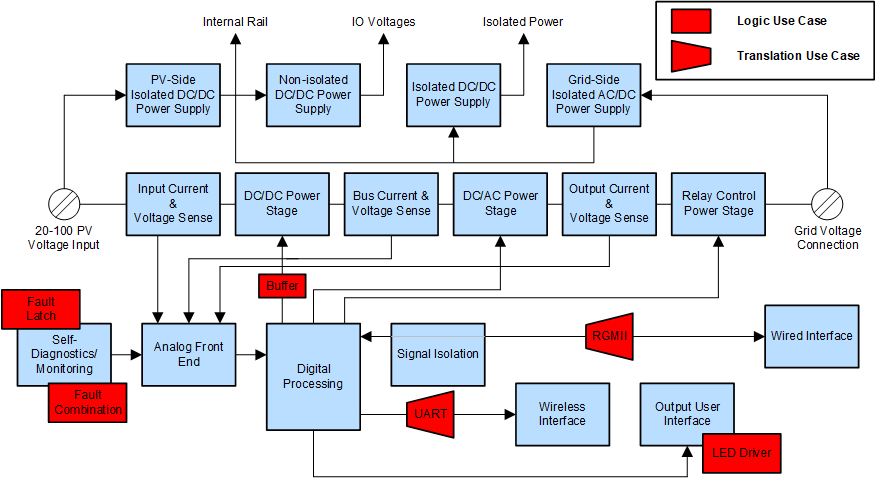SCLA049 August 2021 SN74HCS08
1
Functional Block Diagram
Figure 1-1 shows a simplified micro inverter block diagram to illustrate the logic and translation use cases. Each red block has an associated use-case document. Links are provided in Table 1-1 and Table 1-2. For a more complete block diagram, see the interactive online end equipment reference diagram for micro inverters.
 Figure 1-1 Simplified Block Diagram for
Micro Inverters
Figure 1-1 Simplified Block Diagram for
Micro InvertersLogic and Translation Use Cases
Each use case links to a separate document that provides additional details including a block diagram, design tips, and part recommendations. The nearest block and use-case identifiers are listed to match up exactly to the use cases shown in the provided simplified block diagram.
| Nearest Block | Use-Case Identifier | Use Case |
|---|---|---|
| Self-Diagnostics/Monitoring | Fault Latch | |
| Fault Combination | Use Fewer Inputs to Monitor Error Signals | |
| Digital Processing | Buffer | Redrive Digital Signals |
| Output User Interface | LED Driver | Drive Indicator LEDs |
| Nearest Block | Use-Case Identifier | Use Case |
|---|---|---|
| Wireless Interface | UART | Voltage Translation for Wireless Interface Modules |
| Wired Interface | RGMII | Translate Voltages for RGMII |
Voltage Translation for Wireless Interface Modules
It is common to see micro inverters utilizing wireless interface modules to communicate due to their distributed nature. These modules often use UART for internal communication, and commonly are operating at a different logic voltage level from the primary system controller. The addition of a voltage level translator protects low-power system controllers and ensures accurate communication to the peripheral module.
 Figure 1-2 Example Two-Wire UART Voltage
Translation Block Diagram
Figure 1-2 Example Two-Wire UART Voltage
Translation Block DiagramSee more about this use case in the Logic Minute video Voltage Level Translation for UART Interface
- Some devices support up to 5 Mbps UART communication; most are limited to 115 kbps or less
- Translators enable communication when devices have mismatched logic voltage levels
- Prevent damage to devices that cannot support higher voltage inputs
- Improve data rates over discrete translation solutions
- Protect controller while peripheral is not connected
- [FAQ] How does a slow or floating input affect a CMOS device?
- Need additional assistance? Ask our engineers a question on the TI E2E™ Logic Support Forum
| Part Number | Automotive Qualified | Voltage Translation Range | Features |
|---|---|---|---|
| SN74AXC2T245-Q1 | ✓ | 0.65 V to 3.6 V | Glitch-free power supply sequencing Outputs are disabled when either supply is 0 V Active translation architecture |
| SN74AXC2T245 | |||
| TXB0102 | 1.2 V to 3.6 V to 1.65 V to 5.5 V |
Auto-bidirectional Active translation architecture |
|
| TXS0102-Q1 | ✓ | 1.2 V to 3.6 V to 1.65 V to 5.5 V |
Auto-bidirectional Internal pull-up resistors Passive translation architecture |
For more devices, browse through the online parametric tool where you can sort by desired voltage, channel numbers, and other features.